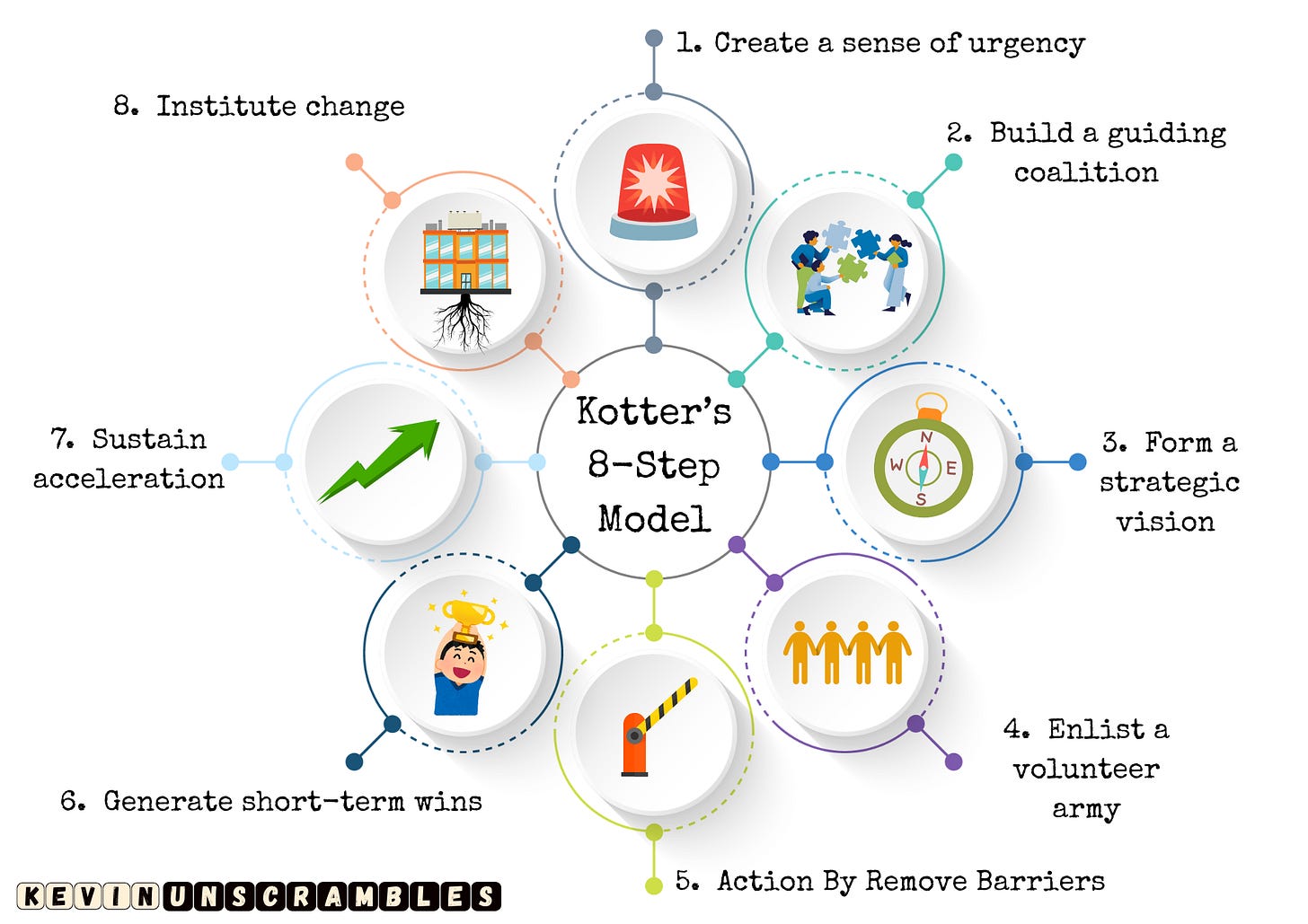Regular readers of Kevin Unscrambles know that change isn’t new, but its pace and scale are redefining how industries compete, markets function, and organisations operate.
Trade tariffs, financial crises, breakthrough technologies, regulatory shifts, pandemics, and fierce industrial competition can upend even the most well-run businesses.
In such an environment, transformation is often a necessity, not a choice. However, transformation doesn’t happen overnight, nor does it occur through leadership willpower alone. It is a process—one that requires building a new system of people, practices, and mindsets. And that process takes a coalition of people—change agents—who champion, coordinate, and sustain change efforts at every level of an organisation.
Change agents are essential to successful transformation, but enthusiasm alone isn’t enough. To succeed, they need a clear roadmap, tools to manage risk, and visible support from leadership above to embed lasting results.
Reinventing an organisation is no small task. It’s a collective effort, and the bigger the organisation, the harder it can be to create a sense of urgency, change the culture, break down barriers, and embed new ways of working. Yet with the right leadership and process, it can be done, as former IBM CEO Lou Gerstner describes in his 2002 memoir, Who Says Elephants Can’t Dance?
In this article, I’ll share a practical framework to help identify and empower those kinds of change agents within an organisation, so that when change is needed, it doesn’t stall, backfire, or fade, but takes root and delivers what is intended.
Kotter’s 8-Step Process: A Roadmap for Change Agents
So, how can leaders develop a clear roadmap to lead and accelerate intentional transformation?
One of the most effective and enduring frameworks comes from Harvard academic John Kotter, whose research into why transformation efforts fail led to the development of his 8-Step Process.
Kotter’s model offers a practical guide to successfully leading change from within. It not only outlines the key stages of transformation needed, but it also emphasises the critical role of people—a coalition of change agents who proactively guide, support, and sustain change at every level. He has subsequently recontextualised his model from a linear process into a set of agile “accelerators” that can be applied flexibly and in parallel with traditional hierarchical business settings.
Let’s take a closer look.
Why Change Agents Matter: Walking Through Kotter’s 8-Step Model
1: Create a Sense of Urgency
To seize a big opportunity to transform, change agents at all levels work together to spot and communicate the strategic threats or opportunities the business faces. They rally as many people as possible to act with urgency before complacency takes hold.
Kotter stresses the importance of urgency as the critical first step because without it, transformation efforts tend to stall. There are many examples in business of organisations that have not acted with a sense of urgency when they should have. For example, Blockbuster’s failure to respond early to Netflix’s disruption of its industry illustrates the cost of missing this sense of urgency.
2: Build a Guiding Coalition
Successful change is not an event; it is a social process. Change agents from across the business, particularly those with positional power, form diverse, committed coalitions that act with urgency and align leadership and operational teams, bridging silos and departments towards a common goal. IBM’s turnaround under Lou Gerstner in the 1990s was driven by such coalitions that unified the company.
3: Form a Strategic Vision and Initiatives
Change agents translate abstract strategy into a clear, relatable vision, a picture of the future, that people can really rally behind. They explain not just the “what” but the “why.” The ultimate vision may not come exclusively from the top; all levels have a role to play.
Sometimes, successful transformative leaders focus on talking more about delivery rather than “vision talk,” but what matters is that there is a clear vision of the future embedded, and the organisation clearly knows why they are engaging in the transformation underway.
4: Enlist a Volunteer Army
Broad engagement is vital. Change agents mobilise grassroots support through good communication about the vision of change and strategic initiatives in a way that many more across the business buy into it and want to play their part in making it happen with a sense of shared ownership.
5: Enable Action by Removing Barriers
Resistance to change, whether cultural, structural, or resource-based, is inevitable. Change agents using good feedback from all silos and levels identify obstacles and work to eliminate them. With the removal of roadblocks, a wider range of employees will see and believe how they can make a real difference.
6: Generate Short-Term Wins
Visible wins energise people across the business, minimise negativity, and build credibility for the change envisioned. Celebrating milestones sustains momentum and goes a long way towards turning sceptics into supporters.
7: Sustain Acceleration
Change is a marathon, not a sprint. It is human nature to take the foot off the pedal after celebrating some early wins. But a few battle wins should not mean the war is won. Change agents must stay focused to ensure that the strategic transformation goal is not prematurely celebrated and stay driven to avoid backsliding once early wins are achieved.
8: Institute Change
Finally, agents embed new behaviours and mindsets into the business culture, ensuring changes stick long-term so that they are eventually a real part of the organisation’s DNA. As Kotter argues, “change sticks when it becomes ‘the way we do things around here.’”
The strength of Kotter’s model lies in its focus on people—a coalition of change agents—who actively drive each stage. Each step depends on the different individuals throughout the organisation who champion change, from senior leaders to informal opinion leaders on the front lines.
What Happens Without Change Agents?
When change agents are absent, transformation efforts tend to fall into familiar traps. Initiatives lose momentum or stall before delivering real results. Resistance, if left unchecked, breeds skepticism that just slows progress even further. Without a unifying force to align people and action across the business, change efforts will remain fragmented across silos, and strategic intent will remain disconnected from practical execution. Meanwhile, old habits will likely persist, culture will stagnate, and innovation will be stifled.
A well-known example is Kodak’s decline, where the absence of internal champions to push digital transformation in the early days of digital photography contributed to what, in hindsight, were costly missed opportunities.
Practical Steps for Building Change Agents
Kotter’s framework is an ideal starting point when it comes to driving organisational change. One of the best ways to build a strong network of change agents is to identify informal opinion leaders within the business—colleagues whom others naturally trust and follow. These individuals often wield more influence than their job titles might suggest.
From there, investing in the development of change leadership skills across the organisation makes a lot of sense, enabling both managers and staff to lead from wherever they stand. Bringing teams together across departments encourages breaking down silos and building momentum through collaboration.
Additionally, maintaining transparency is crucial. Open communication helps build trust, spot challenges early, and rally support. And don’t forget to recognise those who are on board and driving the change effort. A little appreciation goes a long way in motivating colleagues, embedding new behaviours, and keeping the vision of a better future alive.
Change Needs Its Agents More Than Ever
In an age of accelerating disruption, organisations that cultivate and empower change agents clearly hold a decisive advantage. These individuals and teams are the people who turn abstract plans into action, mobilise collective effort, and embed transformation into culture. That is powerful.
Kotter’s 8-Step Process offers a clear, people-centered blueprint for successful change. Leaders and managers must recognise that without change agents, transformation remains an unrealised ambition.
Change needs its agents, not just to lead change but to embody the business’s ability to adapt and thrive in this age of accelerations.
Bonus Reading:
Kotter, J. P. (1996). Leading Change. Harvard Business Review Press.
Kotter, J. P. (2014). Accelerate: Building Strategic Agility for a Faster-Moving World. Harvard Business Review Press.




